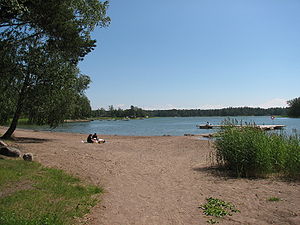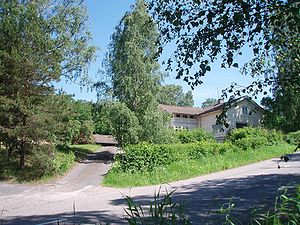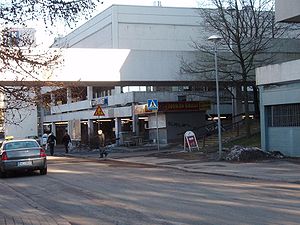
Soukka
Encyclopedia

Swedish language
Swedish is a North Germanic language, spoken by approximately 10 million people, predominantly in Sweden and parts of Finland, especially along its coast and on the Åland islands. It is largely mutually intelligible with Norwegian and Danish...
) is district number 33 of Espoo
Espoo
Espoo is the second largest city and municipality in Finland. The population of the city of Espoo is . It is part of the Helsinki Metropolitan Area along with the cities of Helsinki, Vantaa, and Kauniainen. Espoo shares its eastern border with Helsinki and Vantaa, while enclosing Kauniainen....
, Finland
Finland
Finland , officially the Republic of Finland, is a Nordic country situated in the Fennoscandian region of Northern Europe. It is bordered by Sweden in the west, Norway in the north and Russia in the east, while Estonia lies to its south across the Gulf of Finland.Around 5.4 million people reside...
, located in southwestern Espoo in the main district of Suur-Espoonlahti
Suur-Espoonlahti
Suur-Espoonlahti or Stor-Esboviken is a south-western main district of Espoo, a city in Finland.It contains the districts Espoonlahti, Kaitaa, Latokaski, Nöykkiö, Saunalahti, Soukka and Suvisaaristo....
.
Early history
Soukka is part of the oldest area in Espoo. The oldest discovered signs of habitation in Soukka are from the early metal age. There have been discoveries of bronze ageBronze Age
The Bronze Age is a period characterized by the use of copper and its alloy bronze as the chief hard materials in the manufacture of some implements and weapons. Chronologically, it stands between the Stone Age and Iron Age...
cairn
Cairn
Cairn is a term used mainly in the English-speaking world for a man-made pile of stones. It comes from the or . Cairns are found all over the world in uplands, on moorland, on mountaintops, near waterways and on sea cliffs, and also in barren desert and tundra areas...
s in the area of the old Soukka village.
In public documents, Soukka is first mentioned in 1540, written as Soijckoby. As time passed, the name of the village settled on the Swedish name Sökö. The Finnish Bureau of Geography confirmed the Finnish
Finnish language
Finnish is the language spoken by the majority of the population in Finland Primarily for use by restaurant menus and by ethnic Finns outside Finland. It is one of the two official languages of Finland and an official minority language in Sweden. In Sweden, both standard Finnish and Meänkieli, a...
name as Soukka in 1965.
It is believed the name Soukka means "narrow" in old Finnish. In the Arabic language a Souk is a market. The name may relate to Soukka, being a narrow strip of land, this is only theory, as yet unproven.
In the 1590s, the village of Soukka consisted of a single independent farm
Farm
A farm is an area of land, or, for aquaculture, lake, river or sea, including various structures, devoted primarily to the practice of producing and managing food , fibres and, increasingly, fuel. It is the basic production facility in food production. Farms may be owned and operated by a single...
and its subsidiary buildings. The rate of growth was slow and in 1865 there were two independent farms in the village, with a total population according to census of 49. By the late 19th century, the population of Soukka had grown to 103. In the late 18th century, building work had started on the Sveaborg fortress off the coast of Helsinki
Helsinki
Helsinki is the capital and largest city in Finland. It is in the region of Uusimaa, located in southern Finland, on the shore of the Gulf of Finland, an arm of the Baltic Sea. The population of the city of Helsinki is , making it by far the most populous municipality in Finland. Helsinki is...
. The construction of the fortress increased demand for brick
Brick
A brick is a block of ceramic material used in masonry construction, usually laid using various kinds of mortar. It has been regarded as one of the longest lasting and strongest building materials used throughout history.-History:...
and brick construction began also in the lands of Soukka. Industrialisation got off to a real start in the late 19th century, when the first industrial area was founded on the coast of Espoonlahti
Espoonlahti
Espoonlahti or Esboviken is a district of Espoo, a city in Finland.Areas known as Laurinlahti, Ylä-Kivenlahti and Ala-Kivenlahti are also part of the Espoonlahti district. Greater Espoonlahti also includes Kaitaa, Latokaski, Nöykkiö, Saunalahti, Soukka, Iivisniemi and Suvisaaristo.-See also:*...
. Brick factories in nearby villages increased demand for workers.

In the 1870s, there emerged a strong community of carpenter
Carpenter
A carpenter is a skilled craftsperson who works with timber to construct, install and maintain buildings, furniture, and other objects. The work, known as carpentry, may involve manual labor and work outdoors....
s in the Soukanniemi area, whose activity lasted until the 1930s. The first of them was Anders Viktor Lindström, the most successful of them was Johan Syrjänen, having bought the southern part of the Staffan island off the coast of Soukanniemi. In wintertime, completed furniture was shipped to Helsinki by sled
Sled
A sled, sledge, or sleigh is a land vehicle with a smooth underside or possessing a separate body supported by two or more smooth, relatively narrow, longitudinal runners that travels by sliding across a surface. Most sleds are used on surfaces with low friction, such as snow or ice. In some cases,...
on the ice, in summertime by steam ship.
Modern times

Marina
A marina is a dock or basin with moorings and supplies for yachts and small boats.A marina differs from a port in that a marina does not handle large passenger ships or cargo from freighters....
, the fountain in the centre of the district and the natural beauty of its landscape, examples of which include the Kasavuori hill on the coast of Espoonlahti, an ancient place of signal fires in the defense of the Finnish coastline. Soukka is celebrated in many ways, the most prominent of which is the annual Soukka day, held on the second-to-last weekend of July every year.

